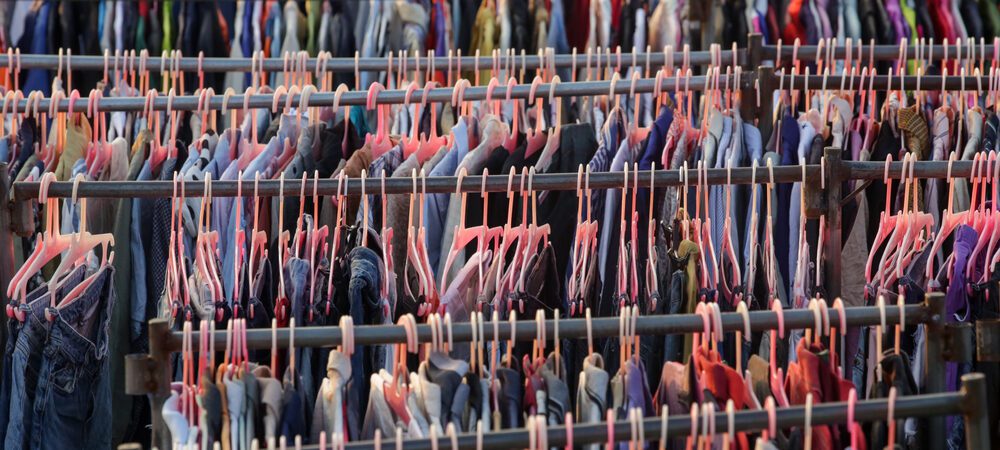Plentiful cheap clothes are a triumph of innovation and markets. Most of human history has been characterized by privation and low‐productivity toil. As one American sharecropper exclaimed in John Steinbeck’s Depression‐era novel The Grapes of Wrath, “We got no clothes, torn an’ ragged. If all the neighbors weren’t the same, we’d be ashamed to go to meeting.”
Today, things are different. People in wealthy countries can order a new outfit for less than a day’s wages. We enjoy new styles and trends that were once reserved for the ultra‐rich. Even our poorest are rarely lacking sufficient clothes and shoes.
Much of this abundance is owed to globalization. Clothing is so plentiful that unwanted new garments are piling up on the beaches of Ghana. African consumers can no longer absorb the quantities shipped to them by rich ones, so they choose the styles they love and discard the rest.
There are, however, critics of these trends, especially the recent phenomenon labeled “fast fashion,” the rapid production of inexpensive, trendy clothing that is quickly made available to consumers, often resulting in short product life cycles. The United Nations Economic Commission for Europe called the fashion industry an “environmental and social emergency” because clothing production has roughly doubled since the year 2000. Their main concerns are fast fashion’s environmental impact and working conditions.
Is apparel a menace? In short, no. Globalization of the clothing industry has been good for the United States and the world.
Clothing Abundance and Globalized Fashion Provide Myriad Benefits
From the runways of Paris and Milan to the shops on Savile Row and the streets of Brooklyn, fashion has long been global and one of the ways people around the world can learn from one another. It used to be, however, that most fashion was reserved for the elite while common folk got by on a few well‐worn staples. The recent explosion of cheap mass‐produced clothes is a testament to the power of specialization and exchange on a global scale. Elizabeth Cline wrote, “If you ever wonder how we went from living in a world of relative clothing scarcity to feeling like we’re swimming in the stuff, ponder no further than China.” One city in China produces most of the world’s socks, over 20 billion pairs a year. This works because of an integrated international supply chain. It was only with the expiration of the Multifiber Arrangement in 2005 that the global textile and apparel trade was fully opened, following decades of gradual liberalization efforts through agreements such as the Agreement on Textiles and Clothing negotiated as part of the Uruguay Round of the General Agreement on Tariffs and Trade (the GATT).
Critics sometimes ignore the social benefits of cheaper clothes that weigh against its costs. Globalization has increased the variety of clothes we can choose from, and we can express ourselves in almost any way imaginable. What The Economist calls “mass customization” is fun. A fashion influencer summarizes the attitude of fans of low‐budget brands like Shein: “People deserve to have nice things.… A lot of us that work regular 9‑to‑5 jobs can’t afford $2,000 shoes.”
But having plenty of textiles is about more than just people looking good or buying new dresses. Abundance means that children have winter hats and burn victims have bandages. And the global nature of fast fashion fosters economic integration and understanding. The exchange of fashion ideas creates a merging of cultures as designers draw inspiration from different traditions and consumers embrace trends from around the world. Fast fashion has the potential to democratize new trends and ideas, making them accessible to a broader demographic.
There are also other ways that cultural exchanges happen. Global supply chains bring people together to solve problems and foster an exchange of businesspeople to run these supply chains. For‐profit clothing businesses achieve the goals of cultural nonprofits such as the Rhodes Trust and the Olympic Foundation for Culture and Heritage. And thanks to the internet, any person in any country can share what they love with a global audience of fans. This is what a rich globalized world looks like.
Textiles Trade Supports Better Jobs—Here and Abroad
Critics also misunderstand that what might be considered a sweatshop in the United States is an improvement over the real‐world alternatives available in poorer countries—a step that Americans themselves took a century ago.
Dana Thomas sums up the sentiment toward trade and technology among fast‐fashion critics in her book Fashionopolis:
“Since the invention of the mechanical loom nearly two and a half centuries ago, fashion has been a dirty, unscrupulous business that has exploited humans and Earth alike to harvest bountiful profits. Slavery, child labor, and prison labor have all been integral parts of the supply chain at one time or another—including today. On occasion, society righted the wrongs, through legislation or labor union pressure. But trade deals, globalization, and greed have undercut those good works.”
The implication that child labor is the result of mechanized manufacturing is backward. Children today have been largely freed from production jobs because of the wealth created by machines and globalization. It is not primarily legislation that creates safer jobs but rather economic growth.
Preindustrial women spent much of their lives spinning thread. In the United States today, it would be illegal to pay as little as these women earned for their labor. The reality was that these women were not very productive because they were working with poor technology, and yet they did the work because it was their best option. Machines and synthetics allow us to produce more textiles with less labor.
To read the full publication, click here.

